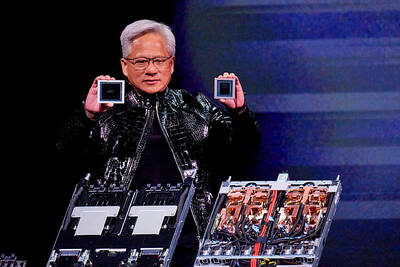AU Optronics Corp (AUO, 友達光電) has suspended production at a plant, which makes polysilicon used in solar wafer manufacturing, in Japan and is assessing potential quake damage to supply chains in the LCD panel industry, the company said.
The Hsinchu-based company said in a statement on Saturday that its manufacturing facilities had not been damaged and there had been no casualties at its Japanese solar-wafer unit, M.Setek Co, in Fukushima Prefecture, one of the areas hardest hit by the magnitude 8.9 earthquake on Friday.
M.Setek produces polysilicon and solar wafers in Soma City, Fukushima Prefecture, both of which are key raw materials for making solar cells. AUO has in recent years expanded into the solar power business, aiming to gain a foothold in the fast-growing green energy market.
AUO has about 800 employees in Japan, with about 700 working at M.Setek, chairman Lee Kun-yao (李焜耀) said yesterday on the sidelines of a job fair in Taipei.
“The [M.Setek] plant was not hit by the tsunami, but ... because of a lack of water and electricity, it is not operational at the moment,” local cable TV network UBN quoted Lee as saying yesterday.
The company downplayed the potential financial impact from the production suspension, adding that M.Setek contributed just 0.3 percent of AUO’s NT$102.62 billion consolidated revenue in the fourth quarter of last year.
As for the possible knock-on effect on the LCD panel industry, Lee said there would certainly be an impact in terms of the upstream supply chain, but that an accurate assessment would require more time.
“We have alternative sources of chemical materials,” Lee said, hinting that the earthquake has had a limited impact on the company’s flat-panel business.
US market researcher IHS iSuppli said on Friday that the earthquake would affect the production of components for LCD panels — including glass, color filters, polarizers, cold cathode fluorescent lamps and light-emitting diodes — as Japanese suppliers play an important role in this line of business.
Meanwhile, Lee said yesterday the company would re-apply to the Investment Commission for permission to change its Chinese investment plan, after the government announced on March 8 that it would allow Taiwanese LCD makers to buy a stake in or merge with Chinese counterparts, as well as invest in Chinese fabs using the same level of technology they currently employ in Taiwan.
In December, the company won government approval to invest US$3 billion in a 7.5-generation fab in Kunshan, China.
ADDITIONAL REPORTING BY CHEN MEI-YING

Nvidia Corp chief executive officer Jensen Huang (黃仁勳) on Monday introduced the company’s latest supercomputer platform, featuring six new chips made by Taiwan Semiconductor Manufacturing Co (TSMC, 台積電), saying that it is now “in full production.” “If Vera Rubin is going to be in time for this year, it must be in production by now, and so, today I can tell you that Vera Rubin is in full production,” Huang said during his keynote speech at CES in Las Vegas. The rollout of six concurrent chips for Vera Rubin — the company’s next-generation artificial intelligence (AI) computing platform — marks a strategic

Enhanced tax credits that have helped reduce the cost of health insurance for the vast majority of US Affordable Care Act enrollees expired on Jan.1, cementing higher health costs for millions of Americans at the start of the new year. Democrats forced a 43-day US government shutdown over the issue. Moderate Republicans called for a solution to save their political aspirations this year. US President Donald Trump floated a way out, only to back off after conservative backlash. In the end, no one’s efforts were enough to save the subsidies before their expiration date. A US House of Representatives vote

Shares in Taiwan closed at a new high yesterday, the first trading day of the new year, as contract chipmaker Taiwan Semiconductor Manufacturing Co (TSMC, 台積電) continued to break records amid an artificial intelligence (AI) boom, dealers said. The TAIEX closed up 386.21 points, or 1.33 percent, at 29,349.81, with turnover totaling NT$648.844 billion (US$20.65 billion). “Judging from a stronger Taiwan dollar against the US dollar, I think foreign institutional investors returned from the holidays and brought funds into the local market,” Concord Securities Co (康和證券) analyst Kerry Huang (黃志祺) said. “Foreign investors just rebuilt their positions with TSMC as their top target,

REVENUE PERFORMANCE: Cloud and network products, and electronic components saw strong increases, while smart consumer electronics and computing products fell Hon Hai Precision Industry Co (鴻海精密) yesterday posted 26.51 percent quarterly growth in revenue for last quarter to NT$2.6 trillion (US$82.44 billion), the strongest on record for the period and above expectations, but the company forecast a slight revenue dip this quarter due to seasonal factors. On an annual basis, revenue last quarter grew 22.07 percent, the company said. Analysts on average estimated about NT$2.4 trillion increase. Hon Hai, which assembles servers for Nvidia Corp and iPhones for Apple Inc, is expanding its capacity in the US, adding artificial intelligence (AI) server production in Wisconsin and Texas, where it operates established campuses. This